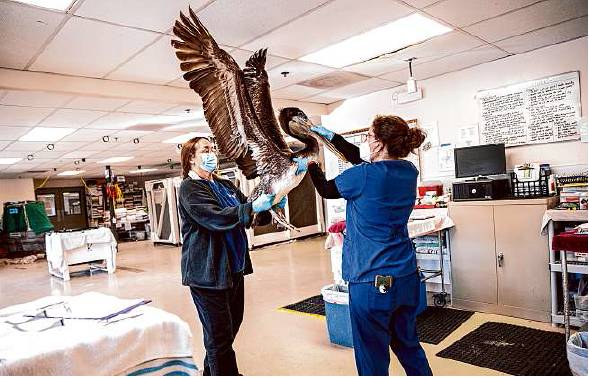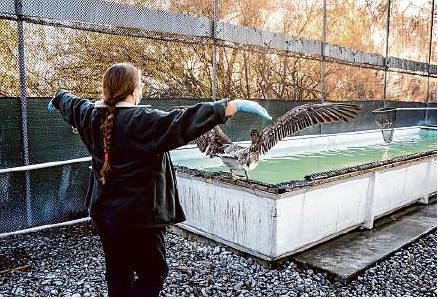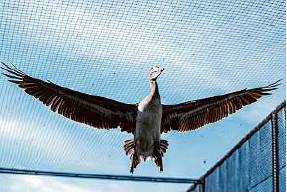Avian flu outbreak’s alarming toll in state
‘Unprecedented’ levels of virus, death in wide mix of wild birds
By Tara Duggan
A Western gull’s wings seize up as it huddles in a crate. The yellow eyes of a snowy egret tremble uncontrollably.
Those are some of the patients at International Bird Rescue in Fairfield with symptoms of avian influenza, part of an outbreak far more deadly than California has ever seen.
“This outbreak with this particular strain of highly pathogenic avian influenza, H5N1, is unprecedented, really,” said Krysta Rogers, senior environmental scientist of avian investigations at the state Department of Fish and Wildlife, speaking of a strain that entered North America a year ago and California in July. “We’re seeing really unprecedented levels of infection and mortality in a very wide diversity of wild birds. We’ve really not encountered anything like this before.”
The highly infectious and deadly strain is hitting Canada geese, falcons, pelicans, bald eagles and turkey vultures across the state, often causing respiratory issues or neurological problems before a swift death. Geese have been seen swimming in circles or walking along with a dazed look. Once they show those symptoms, there is no cure.
Other than a smaller outbreak in wild birds that started in late 2014, the disease in North America has previously been limited mostly to domestic poultry, which could be quarantined and euthanized, keeping its spread in check. As it strikes more wild migratory birds, especially in winter when they travel long distances and spend more time in California, there’s no control over it, scientists say.
“All of us wildlife centers are in a difficult position trying to help these animals because there’s really no treatment for this disease,” said Rebecca Duerr, director of research and veterinary science at International Bird Rescue in Fairfield, which has taken in 75 wild birds with symptoms of avian flu since August. “And in many cases, the first thing that we find out about them is that they’re dead.”
A condor brought to ancestral Yurok territory in Northern California for a reintroduction program was moved to the Oakland Zoo this month for better protection from avian flu, according to a spokesman for the Yurok Tribe. The disease has infected almost 51 million birds in the United States this year, according to the Department of Agriculture. However, it is considered low-risk to humans in the U.S., the Centers for Disease Control and Prevention says.
The highly pathogenic avian influenza came from Europe and started hitting wild bird populations in eastern Canada a year ago. It then moved down the eastern seaboard to Florida, said Bryan Richards, emerging disease coordinator at the U.S. Geological Survey National Wildlife Health Center.
Next, the disease moved into the Mississippi Flyway, then into the Central Flyway and most recently into the Pacific Flyway, which includes Washington, Oregon and California. “The Pacific Flyway birds were kind of latecomers to the outbreak,” Richards said. “But the impacts are certainly growing, measurable and demonstrable in the state of California.”
Since July, avian influenza has been detected in 180 wild birds in California, including 47 in Bay Area counties, according to Rogers. That is a vast undercount of how many birds have died since it only includes dead birds sent for testing, which is done selectively. Not even all the symptomatic birds taken in by International Bird Rescue in Fairfield have been tested for avian flu, due to the time and expense. There have been other reports of shorebirds like snowy plovers and sanderlings showing signs of infection, Rogers said.
Since last December, the virus has been detected in 6,000 wild birds in North America, including great-horned owls, black vultures, crows and some songbirds. That compares with only 100 wild birds during the 2014-15 outbreak (31 in California). This time around the disease is far worse than even the comparative numbers reflect.
In addition, while the 2014-15 outbreak was confirmed in 16 states and 18 wild bird species, this time it has reached 120 species and all U.S. states except Hawaii.
“There’s a lot more virus being shed out into the environment,” Richards said.
The virus usually is spread by waterfowl, especially by what are called dabbling ducks including mallard and teal ducks. While these ducks usually don’t have symptoms or die, they spread the virus to other waterfowl, especially geese. When those birds die, they’re eaten by predatory birds like falcons or scavenger birds like vultures and the virus spreads further.
Richards said the virus has likely just adapted better to being carried by the dabbling ducks, which is why it has lasted so long. In the previous outbreak, H5N1 was taken over by a less harmful low pathogenic avian influenza by spring. During the current outbreak, it persisted through summer and came back with a vengeance in fall, he said.
It also has hit about 10 mammal species in the U.S., including red foxes, skunks, raccoons and black bears, as well as some harbor seals and a dolphin on the East Coast. It can cause illness and sometimes death in those animals. But so far it hasn’t been detected in mammals in California.
The disease is also a potential human pathogen that has infected 856 people and killed 456 globally since 2003. During this outbreak there has been one known case in the U.S. of a person who grew ill after extreme exposure to infected domestic birds, Richards said.
International Bird Rescue staff wear personal protective equipment and treat bird patients the way they would humans with COVID, and haven’t had any issues, Duerr said. The organization relies on donations to cover costs of equipment and treating sick birds.
Unfortunately, usually the only thing wildlife rehabilitation centers can do is humanely euthanize symptomatic birds, which at least prevents them from drowning in the wild and slows the spread of disease because they’re not eaten by other birds.
Richards is looking to Europe, which is about one year ahead of North America in dealing with the illness, to get a sense of how the virus could develop. It will likely spread this winter before tapering off when birds migrate south, and then could have an uptick when migratory birds go north again in early spring, he said.
“It’s always really challenging to have an accurate crystal ball when it comes to these events,” he said. “But if we look to what’s going on in Europe, it suggests that this virus could be with us for a protracted period of time.”
Tara Duggan (she/her) is a San Francisco Chronicle staff writer. Email: tduggan@sfchronicle.com Twitter: @taraduggan




